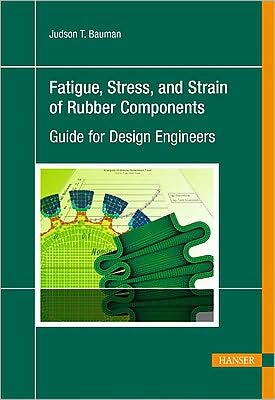

 |

|

The average rating for Fatigue, Stress, and Strain of Rubber Components: A Guide for Design Engineers based on 2 reviews is 3 stars.
Review # 1 was written on 2016-05-06 00:00:00 Dan Walton Dan WaltonMy engineering design bible!! |
Review # 2 was written on 2016-05-25 00:00:00 Elijah Hodges Elijah HodgesGerhard Pahl and Wolfgang Beitz's Engineering Design: A Systematic Approach is a textbook that presents a systematic approach to understanding and practicing design in engineering fields. Although its claim is of generality, its practical examples are drawn from product design and engineering, more specifically, mechanical engineering. This is an excellent book, recommended to everyone interested in design processes, and in particular to everyone interested in engineering design. Main strengths: 1. Any comprehensive, systematic design process with proven use is important. The multi-level, multi-step design process presented here is particularly useful in engineering design (technology is often hierarchical in nature). 2. Holistic nature of the analysis, including links of engineering design to engineering science and engineering technology, to different fields in design and arts, and to different socio-political and legal-professional (normative law, standards) aspects. 3. Excellent aspects: separation of conceptual and technical (implementation, embodiment) parts of the design; iterative evolution of problem and solution; focus on full life-cycle of the product, including costing. 4. Mature presentation of the concepts, with practical examples. I found the examples recognizable, although I have no prior degree or preparation in mechanical engineering. 5. High-quality surveys of the history of (engineering) design, of methods for problem-solving, of alternatives for the components used in the designs presented as examples. Main weaknesses: 1. The claim of process generality seems exaggerated (see points 2-6). In particular, the book seems good for product design, where products need precision manufacturing and are mass-produced. 2. Numerous references to German professional-design standards DIN and VDI, which have parallels but not clear standards internationally. (ISO and IEEE standards cover DIN and VDI only partially, and there seems to be no one-to-one corresponding standard for those used in this book.) 3. Focus on mechanical design is visible in some of the stages proposed in the comprehensive process, e.g., materials or kinematics. Service design is also not covered. 4. Although the process allows evolving the problem and the solution, the stages that allow this are discrete, and possibly not matching reality. 5. This book misses out on the scientific aspects of understanding problems - as complexity increases, gathering meaningful requirements, and in particular quantitative aspects of the problem, requires new approaches that the industry does not have at the moment. 6. There is little room for a number of core tenets of design stemming from fine arts and social sciences. In particular, there is little room for intuition, although the authors agree themselves that Intuition has led to a large number of good and even excellent solutions [page 53]. The argument presented by the authors seems doublethink, because it includes the curious there is a danger that solutions will be circumscribed by preconceived ideas based on one's special training and experience [page 54], which is exactly what the proposed process also leads to. (The authors try somewhat to include intuition, and even explain that This is not meant to detract from the importance of intuition or experience; quite the contrary'the additional use of systematic procedures can only serve to increase the output and inventiveness of talented designers. Any logical and systematic approach, however exacting, involves a measure of intuition; that is, an inkling of the overall solution. No real success is likely without intuition. [page 11]. But how? What share of the process or of the resources to allocate to intution? etc.) The process also contrasts with the holistic processes used in architecture, whose proponents argue that structuring the design process is even detrimental to creativity and intuition, and thus to a high-quality result (e.g., Yes is More: An Archicomic on Architectural Evolution by the Bjarke Ingels Group, Bryan Lawson's excellent books including How Designers Think, etc.) It also goes against the experience of this reviewer, who sees regularly stages of agreed-upon processes being changed, skipped, or swapped with others, as the negotiation and project-management flow progresses through the winds of change and reaction. There are other aspects to consider: economists would argue against the costing and risk models presented here; they discount the Innovator's Dilemma and many other problems associated with innovation. The organizational scientists would argue against a strict, multi-level, high-strung process, which cannot match dynamic markets and can rarely capture the imagination (and thus the sustained effort) of individuals. Etc. 7. The structure of the material is questionable, to the point where reading becomes difficult. In particular, Chapter 7 spans over 200 pages, with many sub-sub-...-sub-headings of which some are not even numbered; the text in this chapter is difficult to parse and understand, and the figures and tables are difficult to locate. |
CAN'T FIND WHAT YOU'RE LOOKING FOR? CLICK HERE!!!